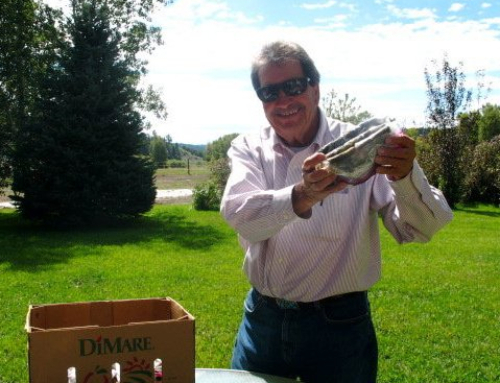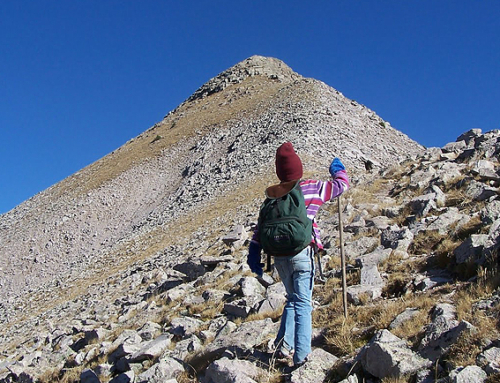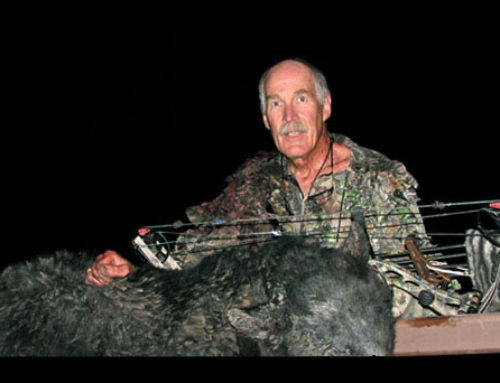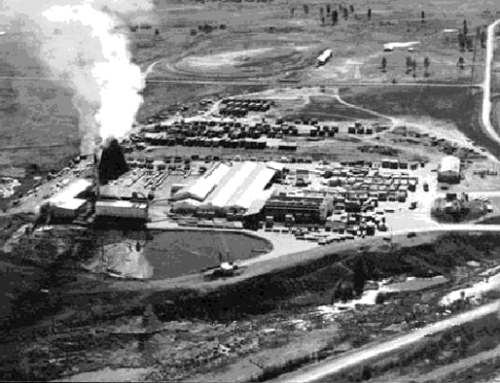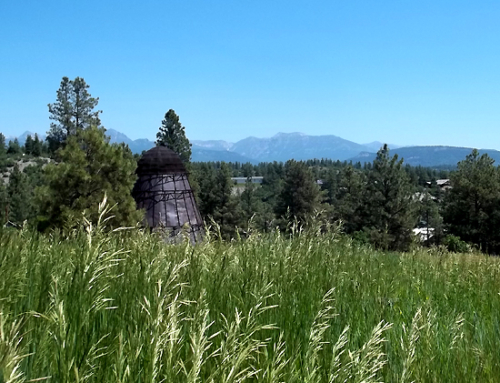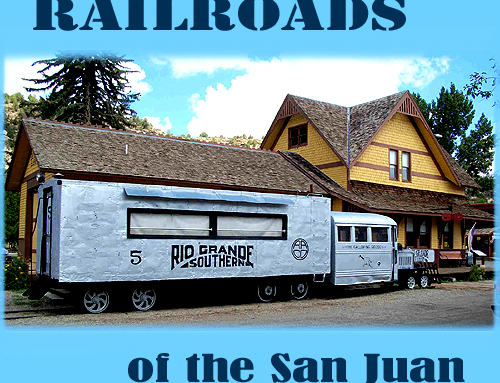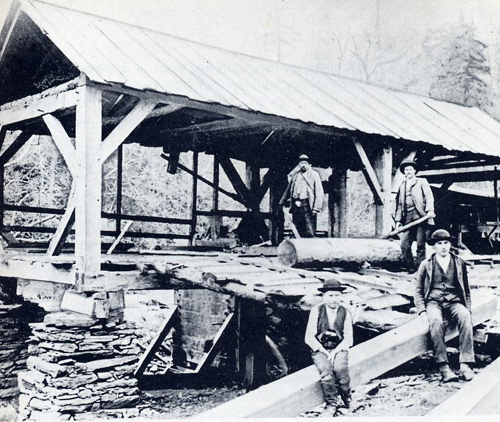 This mill is much the same type and size that Pagosa Country had in many locations in the forest.
This mill is much the same type and size that Pagosa Country had in many locations in the forest.
THE LUMBER DAYS with Margaret Archuleta-Daugaard
Pagosa was a lumbering community. Small, portable sawmills were located in various areas and moved about as new roads were built to transport stands of good timber. The workers lived in tents or portable housing. Margaret and friends had fun traveling the area by hitching rides on the back of timber trucks continuously coming and going. They came to town often transferring logs to the train.
Among others, there was the Bunch Sawmill, the Belardie Sawmill, and the Ponderosa Sawmill. A lady Margaret knew, Lucia Belardie, awoke at 3:00 a.m. to begin cooking for their workers. The workers themselves had a very harsh life.
Margaret laughs remembering some years later at the La Cantina when a new group of tree cutters from Arkansas yelled “TIMBER.” This confused the Archuletas until they were told that “timber” yelled out in a bar to Arkansas timber cutters meant, “we buy drinks for the house.” They were welcomed to yell it all they wanted!
John Hudspeth moved to Pagosa Springs from Oregon and built a large sawmill at the junction of Hwy 84 and Hwy 160. This mill put the smaller mills out of business and became the largest employer in the area. Pagosa timber built houses in Denver and local aspen once provided chopsticks in Japan!
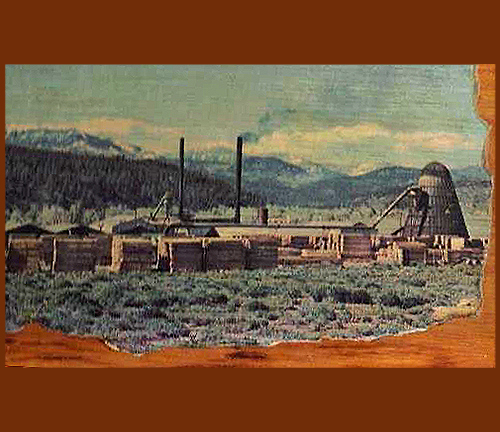
A very interesting story is unfolding concerning this photograph. Tina Willet once lived in Pagosa and attended school here. Later she moved to Oregon. Over the website’s e-mail I received the image and this note from Tina;
Hello!
Do you have any old photos of the San Juan Lumber mill that shut down in the late 70′s? My Dad helped build it and also managed it until the shut down. We live in Oregon and someone bought a photo at a yard sale and it strongly resembles the mill and Pagosa scenery. Thanks for any help.
I identified the image in seconds but took a print to the site at the junction of Hwy 84 and Hwy160 to check. No question about it, the mountains and San Juan Valley cannot be mistaken and the flat topped mountain in the center seals the case. We are currently trying to make contact with the photo’s owner in hope of getting a better copy and one with the left side included. Keep watching here for updates.
It is interesting that the image was found in Oregon. The Hudspeth family owned the San Juan Lumber Company and also held milling interests in Oregon. We likely will never know but it is possible the image was taken to Oregon by one of the Hudspeths.
Their story is interesting and includes great western empire building and a car trip from Oregon to Pagosa with $250,000 in cash in the trunk that was lost during a gambling stop in Las Vegas.
Milling wood on a small scale began supplying the new town with milled lumber. The first Pagosa buildings were log. Later, when better roads were built larger mills exported lumber. Mills dotted the landscape and they were known as “the sawmill octopus” for the tentacle like roads in every direction servicing the mills. Many of those roads we travel today. After the turn of the 20th century the railroad spur came to Pagosa and production increased. By the mid 1950s the Hudspeths bought most of the smaller mills and consolidated production at The San Juan Lumber Mill.
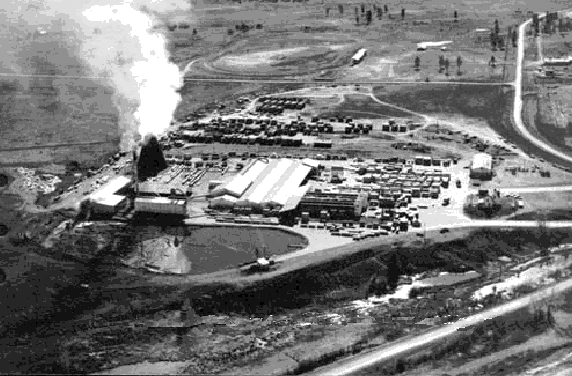
This a second image of the mill found on an Oregon Lumber Mill History website. This must have been the mill at full production judging from the number of buildings and the huge stock of stacked wood. It is easy to see the highways and Mill Creek Road. The oval track, top center, is the first step of the rodeo grounds. The lower building to the far right was a Victorian house the mill manager lived in and is now near the entrance of Holiday Acres Development being rebuilt.
The mill opened in 1958 and closed in the late 1970s. A combination of the Forest Service becoming more protective of the forest, environmental problems when the smoke settled in town and poor management by the Hudspeths brought big milling in Pagosa Country to a stop. When the San Juan Lumber Co. closed it employeed 1/4 of the county population.
The following text Courtesy of Center of Southwest Studies,
Fort Lewis College
The Center of Southwest Studies, Fort Lewis College
TCP=Traditional Cultural Properties
LOGGING AND TIMBER
Logging enjoyed an intense but short-lived prosperity in the area. Logging companies harvested timber between 1890 and 1945. By 1896, the New Mexico Lumber Company, under the direction of Edgar Biggs, C.D. McPhee and J.J. McGinnty, reached Colorado and created the towns of Chromo and Edith. The Pagosa Lumber Company run by Alexander T. Sullenberger soon followed in 1899. Both logging companies built numerous short railroad lines to transport the timber they harvested. While these railroads were specifically oriented toward freight, they raised great hopes and expectations in Pagosa Springs about new connections with the Denver and Rio Grande Railroad line and ultimately with the outside world.
Having depleted most of the timber resources in the San Juan River area, Sullenberger closed his operation in 1916 and moved on to other ventures in the Pagosa Springs area. His Pagosa and Northern Railroad continued under the Denver and Rio Grande Railroad’s ownership to provide a railroad connection (described by many as a bumpy experience at best) between Pagosa Springs and the main Denver and Rio Grande line located about 25 miles to the south in Pagosa Junction. The New Mexico Lumber Company moved to the Dolores area, building what was Colorado’s largest sawmill in 1924 and establishing a townsite named McPhee. New Mexico Lumber harvested timber until 1933. Resource depletion and the Depression ended any major lumbering activity in the region, although lumber mills operated sporadically in Pagosa Springs, Durango and the Dolores area until the mid 1970s. Very little material culture remains of the sawmill operations. A recent headline in a Pagosa Springs real estate guide touted the removal of the ugly eyesores that were the remains of the last major sawmill in Pagosa Springs. In the Dolores area, anything left of the McPhee townsite is under McPhee Reservoir.
Cultural resource surveys of the old logging railroad rights of ways and abandoned towns would provide new information about lumber operations in Southwest Colorado. A number of former sawmill employees live in the Pagosa Springs area. Some of the long term USFS employees stationed in the Pagosa Springs or Dolores offices may know of good candidates for interviews about this topic.
Rio Grande, Pagosa and Northern Railway (1899-1936)
Among several rail branches and spurs built north and south of the Denver and Rio Grande, was the Rio Grande, Pagosa and Northern Railway, built northward from Pagosa Junction to Pagosa Springs in 1899-1900. The line was built by the Pagosa Lumber Company under an agreement with the Denver and Rio Grande Railroad to eventually turn the line over to the D&RG. It carried lumber and sometimes other freight, sheep, mail, and passenger trains to and from Pagosa Springs. In 1906 the line became the D&RG Pagosa Springs Branch of the D&RG Railroad, which operated the line until the Depression hit. During its peak, three branches continued northward from Pagosa Springs.
B. Pagosa Lumber Company Railroad (1906-1916)
The Pagosa Lumber Company operated this subsidiary, running south along the San Juan River from a point west of Pagosa Springs. It had more than fifty miles of lumber spurs.

